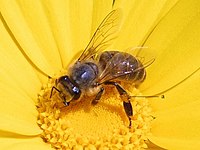Apoidea
| Apoidea | |
|---|---|
 |
|
| Apis mellifera, the western honeybee | |
| Scientific classification | |
| Kingdom: | Animalia |
| Phylum: | Arthropoda |
| Class: | Insecta |
| Order: | Hymenoptera |
| Suborder: | Apocrita |
| Superfamily: | Apoidea |
| Subgroups | |
Incertae sedis |
|
Incertae sedis
The superfamily Apoidea is a major group within the Hymenoptera, which includes two traditionally recognized lineages, the "sphecoid" wasps, and the bees. Molecular phylogeny demonstrates that the bees arose from within the Crabronidae, so that grouping is paraphyletic.
Bees appear in recent classifications to be a specialized lineage of crabronid wasps that switched to the use of pollen and nectar as larval food, rather than insect prey; this makes the Crabronidae a paraphyletic group. Accordingly, bees and sphecoids are now all grouped together in a single superfamily, and the older available name is "Apoidea" rather than "Sphecoidea" (which, like Spheciformes, has been used in the past, but also defined a paraphyletic group and has been abandoned).
As bees (not including their wasp ancestors) are still considered a monophyletic group, they are given a grouping between superfamily and family to unify all bees, Anthophila.
...
Wikipedia
